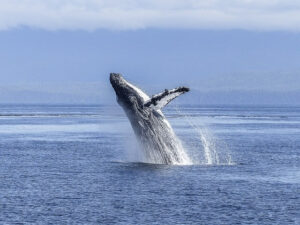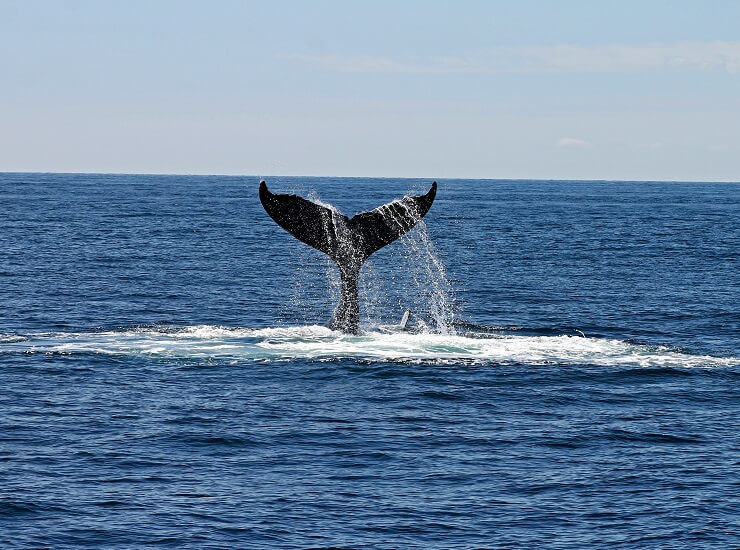Whale song, bewitching melodies echoing in the depths of the ocean. Have you ever found yourself daydreaming about the mysteries of the deep blue sea?
Look no further, for the answer to one of the ocean’s greatest mysteries is about to be revealed! The enchanting and captivating songs of whales have serenaded the seas for centuries, but what do they really mean?
It’s time to strap on your scuba gear and dive into the fascinating world of whale song!
From their complex structures to their mysterious purposes, we will take a deep dive into the enigma of whale communication.
Grab your underwater microphones and set off on a journey to discover the magic behind these magnificent melodies.
Prepare to be swept away by the mystery of whale song!
A brief overview of whale song and its significance
Whale songs are complex vocalizations produced by some whale species, particularly humpback whales. These songs can last for hours and consist of repeated patterns of moans, cries, and whistles.
The exact purpose of whale song is not yet entirely clear, but researchers believe it serves several purposes, including mating and communication between individuals.
Humpback whale songs are particularly unique in that they are learned and passed down within a group, rather than being innate.
This means that each population of humpback whales has a unique song that evolves over time.
Songs also seem to have regional variations, with different populations of humpback whales singing different songs even when they are in close proximity to each other.
The importance of whale songs lies in their potential to provide information about the social and communicative abilities of these fascinating creatures.
In addition, songs can also serve as a tool to monitor the health of whale populations and detect changes in their behavior, which can help inform conservation efforts.
Overall, whale song is an important aspect of the natural world and provides valuable information about the behavior and social structures of these magnificent creatures.
Whale songs could reveal deep beneath
Whale songs are a fascinating and mysterious aspect of the underwater world. These complex vocalizations, which can travel great distances through the ocean, offer researchers a glimpse into the lives and behaviors of whales.

Whale in the depths of the ocean
By studying the songs, scientists can gain insights into the communication patterns and social dynamics of these magnificent creatures.
Additionally, whale songs can also reveal information about the ocean’s environment, including information about water temperature, pressure, and other physical parameters.
As the whales sing, they are essentially taking a snapshot of the ocean’s conditions at that moment in time.
This data can be used to understand how the ocean is changing over time and how these changes may impact the marine ecosystem and the animals that live within it.
Furthermore, the study of whale songs has the potential to reveal the presence of previously unknown species or ecosystems in the deep ocean.
As whale songs are unique to each species, their analysis can help to identify new populations and expand our understanding of the diversity of life in the ocean.
The fascination and ongoing research on whale song
These underwater melodies have fascinated humans for decades and continue to be the subject of much research and fascination.
For starters, did you know that whales have the longest pop songs in the animal kingdom?
Humpback whale songs can last up to 20 minutes and consist of repeated patterns of moans, cries and whistles.
It is as if they are singing ballads to their ocean friends and we are lucky enough to hear!
Why are they singing in the first place?
It is not yet clear, but scientists believe it may be to attract a mate, to establish dominance, or simply for fun (who doesn’t love a good song?).
Each population of humpback whales has its own unique song that evolves over time, fascinating in my opinion. It is as if they have their own underwater musical tradition, like the bards of the sea!

Humpback whale
There are always studies going on about whale song, and new discoveries are being made all the time.
Just recently, researchers discovered that some whale songs can travel thousands of miles across the ocean, making them the best songs for ocean karaoke.
Who knows what other amazing things we will discover about these underwater songs in the future?
So if you find yourself by the ocean and hear beautiful music coming from beneath the waves, don’t be afraid to stop and listen.
You never know, you might be lucky enough to witness a whale concert! And remember, beautiful whale songs never end!
The purpose of whale songs
The exact purpose of these songs is still not entirely clear, but researchers have advanced several theories over the years, including:
- Communication: Whale songs may serve as a means of communication between individuals, allowing them to exchange information about food sources, mating opportunities and potential threats. Some scientists have also suggested that whale songs may play a role in maintaining group cohesion and facilitating social bonds.
- Mating: Another theory is that whale songs are used for mating. For example, male humpback whales are known to sing elaborate songs in an attempt to attract a mate. In this scenario, the songs function as a kind of underwater serenade, showcasing the male’s vocal prowess and suitability as a potential mate.
- Navigation: A third theory is that whale songs may serve as a form of navigation, helping whales locate food sources or navigate complex underwater environments. Some researchers have speculated that the repeated patterns of whale songs may help whales orient themselves and keep track of their position in the ocean.
It is worth noting that many of these theories are not mutually exclusive, and it is possible that whale song serves multiple purposes.
For example, a song may serve as both a means of communication and a form of navigation.
As with many aspects of whale behavior, further research is needed to fully understand the purpose of whale songs.
Evidence to support each theory
The exact purpose of whale songs remains somewhat of a mystery, but there is evidence to support each of the theories advanced by researchers over the years:
- Communication: Researchers have observed that whales respond to each other’s songs, suggesting that they are indeed communicating in some way. For example, when a whale starts singing, other whales in the area may change their behavior in response. In addition, different whale populations have been found to have distinct songs, which could be used to differentiate groups and facilitate communication within and between populations.
- Mating: Evidence for the role of whale songs in mating is strongest in humpback whales, where males are known to have elaborate songs during the breeding season. The songs are unique to each population and evolve over time, which could help attract mates and differentiate groups. In addition, researchers have observed that female humpback whales are more likely to mate with males that sing longer and more complex songs, suggesting that songs actually play a role in attracting mates.
- Navigation: Evidence for the role of whale songs in navigation is a bit more speculative, but there are indications that repeated patterns in whale songs may help whales orient themselves and navigate the ocean. For example, some researchers have speculated that the songs may serve as a kind of underwater map, helping whales locate food sources or navigate complex underwater environments. In addition, it has been observed that some whale species use echolocation or biosonar to orient themselves and find food, which could be related to their vocalizations.
It is worth noting that many of these theories are not mutually exclusive, and it is possible that whale songs serve multiple purposes.
The structure of whale songs
Whale songs are complex vocalizations that exhibit a large number of structures and patterns.
Depending on the whale species, songs can be composed of a variety of sounds, including moans, cries, whistles, and other vocalizations.
One of the most striking features of whale songs is their repetition. For example, humpback whale songs consist of repeated sequences of sounds that can last several minutes.
These patterns can be incredibly complex, with different sounds repeated in different orders and with varying intervals between repetitions.
Another characteristic of whale songs is their hierarchical structure. In other words, whale songs are composed of smaller units that are repeated to form longer sequences.
For example, the song of a humpback whale may consist of a sequence of moans, followed by a sequence of cries, followed by a sequence of whistles, and so on.
Finally, whale songs are known to evolve over time: different whale populations have unique songs that may change from year to year.
This suggests that songs are not simply the result of random vocalizations, but are instead the product of a complex and evolving communication system.
The structure and patterns of whale songs are one of the most intriguing aspects of these vocalizations and continue to be the subject of much research and investigation.
By better understanding the complexity of whale songs, researchers hope to gain insights into the ways in which whales communicate and interact with each other in the ocean.
Differences between the songs of different whale species
The songs of different whale species can vary greatly in both structure and content. Some of the main differences between the songs of different whale species include:
- Species specificity: Some whale species are known to produce songs, while others do not. For example, humpback, gray, and blue whales sing, unlike killer whales and sperm whales.
- Song complexity: Song complexity can vary greatly among different whale species. For example, the songs of humpback whales are known for their complex repeated patterns, while those of blue whales are generally much simpler and consist of a series of low-frequency moans.
- Song length: The length of songs can also vary greatly among different whale species. For example, the songs of humpback whales can last several minutes, while those of blue whales are usually much shorter and last only a few seconds.
- Content: The content of whale songs can also vary between species. For example, humpback whale songs are often characterized by a variety of different sounds, including moans, cries, whistles and other vocalizations, while blue whale songs consist mainly of low-frequency moans.
- Geographic variation: Different populations of the same whale species may also have different songs. For example, humpback whales from different oceans have been found to have unique songs, which could be used to differentiate groups and facilitate communication.
These differences between the songs of different whale species highlight the complexity and diversity of whale communication in the ocean.
By studying the songs of different species, researchers hope to better understand the ways whales communicate and interact with each other in their underwater world.
Whale songs play an important role in the social behavior of many whale species. Some of the main ways in which whale songs are believed to influence social behavior are:
- Communication: Whales are known to respond to the songs of others, which suggests that these vocalizations serve as a form of communication between individuals. For example, researchers have observed that when a whale begins to sing, other whales in the area may change their behavior in response, such as swimming closer or diving deeper.
- Mating: In some whale species, such as humpback whales, singing is believed to play a role in attracting mates. For example, male humpback whales are known to sing elaborate songs during the breeding season, which could help attract females and differentiate males.
- Group cohesion: Whale songs may also help promote group cohesion and maintain social bonds within populations. For example, some researchers have hypothesized that whales may use songs to identify members of their own group and avoid those of other groups.
- Territorial behavior: In some cases, whale songs may also be used to assert territoriality and establish dominance within a population. For example, humpback whale males have been observed to sing at a higher volume and frequency when in close proximity to other males, which could be a way of establishing dominance and demarcating territory.
These are just a few examples of how whale songs may play a role in the social behavior of these fascinating marine mammals.
By studying the songs of different species and populations, researchers hope to better understand the ways in which whales communicate and interact with each other in the ocean.
History of whale song research
The study of whale songs has a rich and fascinating history spanning several centuries.
Some milestones in the history of whale song research are:
- Early observations: The first recorded observations of whale song date back to antiquity, with evidence from Greek and Roman writers describing whale song as melodic and harmonious.
- Modern scientific study: The modern scientific study of whale songs began in the mid-20th century, with the first systematic studies of these vocalizations conducted in the 1950s and 1960s. During this period, researchers began using underwater microphones to listen to and record whale songs in their natural habitats.
- Advances in technology: In the 1970s and 1980s, advances in underwater recording technology enabled researchers to collect more detailed and comprehensive data on whale songs. This led to a greater understanding of the structure and patterns of these vocalizations and their significance for whale behavior and communication.
- Global Collaboration: In the 1990s and 2000s, the study of whale songs became increasingly global, with researchers from around the world collaborating to share data and insights. This has led to a deeper understanding of the diversity of whale songs in different species and populations.
- Conservation Efforts: In recent years, the study of whale songs has taken on new significance: researchers use these vocalizations to monitor the health and abundance of whale populations and to inform conservation efforts.
How our understanding of whale songs has evolved over time
Understanding of whale songs has evolved significantly over time as researchers have developed new technologies and methods to study these vocalizations.
Among the main ways in which our understanding of whale songs has evolved are:
- Increased complexity: Early studies of whale songs suggested that these vocalizations were relatively simple and repetitive, but as our knowledge has increased, we now recognize that whale songs are incredibly complex and intricate. Some whale songs can last for hours and include hundreds of unique elements, demonstrating the remarkable creativity and intelligence of these animals.
- Differentiation among species: Initially it was thought that all whale songs were similar, but as our knowledge increases, we now recognize that there are significant differences between the songs of different whale species. These differences may include differences in song structure, patterns and frequency and reflect the unique adaptations of each species to its specific environment and social context.
- Multiple functions: Whale songs were initially thought to serve a single purpose, such as communication or navigation. However, our knowledge has grown to recognize that these vocalizations likely have multiple functions, including communication, navigation and mate attraction.
- Geographic variations: Early studies of whale songs focused primarily on a single population or species, but as our knowledge grows, we now recognize that there can be significant geographic variation in whale songs even within a single species. For example, researchers have found that the songs of humpback whales in different oceanic regions can differ, suggesting that these vocalizations are influenced by the specific environmental and social conditions of each area.
We can certainly say that overall, our understanding of whale songs has grown significantly over time, reflecting advances in technology and methods used to study these vocalizations.
Certainly, as we continue to study whale songs, we can expect to gain even more in-depth knowledge about the complex and fascinating behaviors of these beautiful animals.
Methods used to study whale songs
There are several methods used to study whale songs, among the most important ones are:
- Underwater microphones: One of the most common methods of studying whale songs is the use of underwater microphones, also known as hydrophones. These devices allow researchers to listen to and record the songs of whales in their natural habitats, providing valuable information about the structure and patterns of these vocalizations.
- Satellite tracking: Another important method for studying whale songs is satellite tracking, which involves attaching a device to the whale that allows researchers to follow its movements and record its vocalizations. This provides a broader picture of whale behavior and allows researchers to study the relationships between whale songs and other aspects of whale behavior, such as migration patterns.
- Autonomous underwater vehicles (AUVs): Autonomous underwater vehicles are becoming increasingly important for the study of whale songs because they allow researchers to collect data at depth without disturbing the whales. These vehicles can be equipped with underwater microphones, cameras, and other sensors, allowing researchers to gather detailed information on whale songs and other aspects of whale behavior.
- Acoustic analysis: Acoustic analysis is a key tool for studying whale songs, as it allows researchers to examine the complex structure and patterns of these vocalizations in great detail. This can include analysis of the frequency, duration and rhythm of the songs, as well as the types of sounds and calls used.
- Behavioral observations: Finally, behavioral observations are an important component of the study of whale songs, as they provide valuable insights into the context and meaning of these vocalizations. For example, researchers can observe interactions between whales and their social groups, as well as the whales’ reactions to different environmental conditions, to gain a deeper understanding of the significance of whale songs in their lives.
The challenges and limitations of studying whale songs
Despite the advances in technology and methods used to study whale songs, there are still significant challenges and limitations in this research. Some of the main challenges are:
- Environmental conditions: The study of whale songs can be difficult due to harsh environmental conditions in the ocean, including high levels of noise pollution, extreme weather conditions and limited visibility. These conditions can make accurate recording and analysis of whale songs difficult and can also affect the behavior of the whales themselves.
- Cost and logistics: The study of whale songs often requires significant resources, including specialized equipment, trained personnel, and access to research vessels. This can pose significant challenges for researchers, especially in remote locations or areas with limited infrastructure.
- Ethics and safety: The study of whale songs also raises ethical and safety issues, as the proximity of research vessels and other equipment to whales can be disruptive and potentially harmful. Researchers must take care to minimize the impact on whales and their habitats while ensuring the safety of personnel and equipment.
- Interpreting meaning: Finally, interpreting the meaning of whale songs is a significant challenge, as not much is yet known about these vocalizations. Researchers must rely on a variety of indirect methods and evidence, such as behavioral observations, to understand the purpose and meaning of whale songs.
Despite these challenges, researchers continue to study whale songs, using a variety of innovative methods and technologies to gain a deeper understanding of these fascinating animals and their vocalizations.
As our knowledge continues to grow, we can expect to learn even more about the complex and important role that whale songs play in the lives of these magnificent creatures.
The future of whale song research
Efforts are underway to better understand whale songs, including the development of new technologies and methods for data collection and analysis.
For example, researchers are exploring the use of machine learning algorithms to analyze large whale song datasets, which can help identify patterns and insights that would be difficult for human observers to detect.
Other researchers are using autonomous underwater vehicles (AUVs) to collect whale song data in remote and hard-to-reach areas, which can provide valuable new insights into the world of whale communication.
The potential for new discoveries and insights into the world of whale communication
The future of whale song research is full of potential for new discoveries and insights into the world of whale communication.
As our understanding of these vocalizations continues to grow, we can expect to learn more about the complex social and behavioral interactions of whales, as well as the relationships between whale songs and other aspects of their lives, such as migration patterns, foraging behavior, and population dynamics.
In addition, there is also potential for the development of new conservation and management strategies based on a better understanding of whale songs.
For example, researchers may be able to use whale song data to monitor changes in whale populations or to develop new techniques to mitigate the impact of noise pollution and other human activities on whale populations.
We are confident that, funding permitting, the future of whale song research is full of exciting possibilities and there is still much to discover about these fascinating and complex vocalizations.
Conclusion
Whale songs are a fascinating and complex aspect of their behavior that continues to fascinate researchers and the public.
With their intricate patterns and structures, these vocalizations play a fundamental role in the lives of whales, serving a variety of purposes, including communication, mating, and navigation.
Despite significant advances in the understanding of whale songs in recent decades, there is still much to be learned about these vocalizations and their meaning.
Ongoing research using a range of innovative technologies and methods is helping to shed new light on the world of whale communication and the important role that whale songs play in the lives of these magnificent creatures.
The future of whale song research is full of exciting possibilities, with the potential for new discoveries and insights into the world of whale communication.
These discoveries have the potential to inform conservation and management strategies, helping to ensure the survival of whale populations and their habitats in the face of continued human activities and environmental pressures.
Overall, the study of whale songs represents a rich and ongoing field of inquiry with the potential to deepen our understanding of these magnificent creatures and their complex vocalizations.
Whether for scientific, conservation or simply human interest purposes, the study of whale songs continues to fascinate and inspire people around the world.










